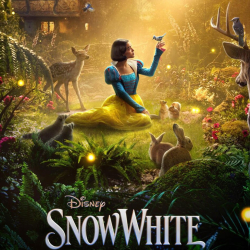A Journey to a Fabled Realm
I was immediately drawn into an enchanting world the moment I began playing Snow White. This game evoked a sense of nostalgia with its fairytale premise while simultaneously presenting inventive mechanics and surprises that refreshed my perception of classic narratives. I found myself wandering through vibrant forests, mystical castles, and quaint villages that had been lovingly rendered with a delicate balance of whimsy and intrigue. Every moment felt organic, as if each step further into the realm was intertwined with lessons about courage, friendship, and the eternal struggle between darkness and light.
From the outset, the narrative offered layers ripe for exploration. I experienced the game not merely as a series of challenges to overcome but as a continuous unfolding of fate and choice. The ingenuity embedded in Snow White’s design compelled me to revisit well-known scenes with a fresh perspective—a deeply personal encounter with the art of storytelling reimagined for modern adventurers.
A Living Story: The Tale Unfolds
As I progressed deeper into Snow White, I began to see the story shift from a static fairytale to a dynamic environment of evolving narratives. The characters around me weren’t bound to one-dimensional roles; instead, they exuded distinctive personalities that grew more intricate as the game advanced. I particularly appreciated the way minor characters provided subtle hints to their past and present desires, inviting me to explore side quests that revealed the hidden layers behind each smile and frown.
The juxtaposition of truth and mystery resonated with me as I made choices that intertwined with different narrative branches. I often paused to consider the metaphorical significance behind every interaction. It wasn’t just the magic of a sleeping princess or the lurking menace of an envious queen—it was the richness of human emotion and experience transposed onto a fantastical canvas. I found moments of joy, despair, and even hope all coexisting within the narrative corridors, each one urging me to press on despite the challenges encountered along my journey.
Artistry Beyond the Page
The visual presentation of Snow White was akin to stepping into a living painting, each frame meticulously crafted to evoke wonder. I was captivated by the hand-drawn aesthetics that bridged classical artistry with contemporary design sensibilities. The animations moved gracefully, turning every gesture and fleeting moment into a piece of art in motion. Every background was steeped in detail—a tapestry of nature, architecture, and light that invited me to immerse myself fully in the otherworldly charm of this fairytale.
Exploring the landscapes, I noticed that the designers had employed a range of color palettes to differentiate the worlds within the game. Warm hues bathed familiar scenes of the countryside, while cooler tones revealed hidden dangers in darker, mystifying environments. The contrast between these color schemes not only served as a navigational aid but also as a visual metaphor for the duality at the heart of the story. For me, these artistic choices elevated the gaming experience from a simple digital recreation of familiar lore to a heartfelt tribute to artistic expression.
Gameplay that Invites Heartfelt Engagement
Snow White’s gameplay mechanics struck a perfect balance between challenge and accessibility, making me feel as though my actions were both meaningful and consequential. The seamless integration of exploratory segments, puzzle-solving opportunities, and occasional combat-like sequences ensured that I was continually engaged. I appreciated how the game allowed me to move at my own pace, giving due emphasis to thoughtful decision-making without being overly punitive.
One aspect that particularly fascinated me was the freedom to interact with an array of objects scattered across the realm, each holding potential clues or secrets. These interactive puzzles were designed not only to engage my problem-solving skills but also to immerse me further into the lore that surrounded each artifact. I discovered that even the simplest actions—whether choosing a route through a tangled forest or engaging in light-hearted banter with townspeople—contributed to a deeper understanding of the magical world I was exploring.
Interfaces that Echo Elegance and Simplicity
The user interface of Snow White was a masterclass in understated design. At every turn, I experienced an interface that was both functional and elegant, echoing the overall ethos of the game. The layout was intuitive, with clearly indicated pathways and interactive elements that never disrupted the immersive flow of the narrative. I found that the minimalistic design did not detract from the grandeur of the experience; rather, it served to enhance my interaction with the world by keeping distractions to a minimum.
Every menu, icon, and on-screen prompt was placed where it could inform me without overwhelming my senses. The attention given to details such as font choice and button responsiveness reinforced the notion that every aspect of the game was meticulously curated. This thoughtful approach meant that I rarely had to pause to reorient myself—every step, every pause was part of a smooth, engaging experience that made me feel intimately connected to the unfolding story.
Interactive Surprises and Intellectual Quests
Throughout my journey, I encountered numerous challenges that transcended mere obstacle courses. Snow White is not a game that simply tests reflexes; it also provokes intellectual curiosity. I engaged with puzzles that required more than a mere click or swipe—they demanded patience, creativity, and a willingness to think outside conventional boundaries. Some quests led me to ancient libraries full of cryptic clues, while others had me deciphering riddles left behind by characters with mysterious pasts.
This element of intellectual pursuit was one of the aspects that I found particularly appealing. Instead of relying solely on repetitive actions, the game continuously rewarded thoughtful exploration. The puzzles often revealed additional layers of narrative, with each solution providing a small window into the lore of the kingdom. I cherished these moments of quiet reflection where the challenge was less about speed and more about appreciating the delicate interplay between mystery and revelation.
Delving into the Mystical Mechanics
There is a certain magic in the way Snow White employs its game mechanics to blur the lines between story and play. Many of the interactions felt like organically woven elements of the narrative rather than separate, isolated mini-games. I appreciated the way the mechanics often reinforced thematic elements. For instance, when I engaged with enchanted mirrors, the reflections were not just visuals; they were interactive portals to subtle insights about the characters I encountered and the world they inhabited.
The comprehensive control scheme was designed to be both accessible and deep. Whether I was performing quick maneuvers during sequences of tension or taking my time to solve intricate puzzles, I felt a palpable connection to the mechanics underpinning the experience. The game excelled at making me feel truly present in this murmuring, enchanted world—a place where my decisions and interactions had genuine narrative weight.
Magical Soundscapes and Enchanting Melodies
The auditory landscape of Snow White was as richly constructed as its visual counterpart. As I traversed through sun-dappled clearings and eerie, shadowed corridors, I found myself appreciating a musical score that was both ethereal and deeply emotive. The sound design was crafted with an attention to detail that allowed every rustle of leaves and whisper of wind to contribute to a larger symphony of the realm. I often paused, captivated by the layered score that elevated the atmosphere from ordinary to extraordinary.
The choice of instruments and melodic progressions felt intimately tied to the emotional tenor of my journey. Whether it was the soft plucking of a harpsichord during moments of introspection or a soaring orchestral swell that accompanied moments of triumph, the soundscape constantly resonated with the core themes of the game. I took pleasure in discovering hidden musical motifs that would echo later in the experience, as if the world itself was communicating its narrative through rhythm and sound.
Innovative Narration Through Visuals
One of the aspects that particularly stirred my imagination was the way Snow White narrated its story through visual cues rather than relying solely on spoken or written dialogue. I encountered sequences where the environment itself spoke volumes—through the language of shadows, subtle color shifts, and clever visual metaphors. These moments felt remarkably cinematic to me, evoking an emotional response as I pieced together the story from cues scattered like a puzzle across each scene.
I often found myself pausing to absorb the intricate details that the game presented. A delicate vine curling around an ancient stone or the melancholic glow of a distant moon often hinted at underlying stories that were left for me to piece together. Such visuals were especially powerful when combined with moments of interactive discovery, as they transformed what might have been incidental background decorations into significant narrative components. It was a reminder that art and narrative are inseparable in the hands of a talented storyteller.
Intimate Reflections on Emotional Rollercoasters
As I delved further into the realms of Snow White, my emotional connection to the world deepened in ways that I had not anticipated. The game masterfully balanced moments of lighthearted joy with intervals of tension and melancholy. I experienced personal triumphs when successfully navigating tricky puzzles, and I also encountered moments of quiet sorrow during passages that reminded me of lost hopes or enduring adversity. These fluctuations in atmosphere were not random but were carefully orchestrated to mimic the unpredictable nature of life itself.
I found myself reflecting on my own journeys while traversing the landscapes of this enchanted world. There were moments when the narrative echoed deeply personal themes, resonating with memories of love, loss, and the bittersweet beauty of change. Each encounter, whether cheerful or heart-wrenching, felt sincere and immersive. The emotional cadence of the game served as an unspoken dialogue with my innermost reflections, filling me with a sense of wonder and melancholy alike.
Revelations in the Heart of the Enchanted Woods
My exploration of the mystical woods within Snow White led to discoveries that left me both astounded and introspective. The enchanted forests, rendered in lush detail and layered with hidden meaning, offered more than just a scenic backdrop—they were a central character in their own right. Wandering along winding paths guarded by ancient trees, I encountered symbols and relics that hinted at histories forgotten and secrets long concealed.
Every corner of these woods seemed to reveal a new facet of the kingdom’s lore. I uncovered shrines, whispered legends, and even cryptic murals that challenged me to piece together a story from fragments. This organic blend of exploration and narrative was particularly appealing as it allowed me to experience the world at my own pace while continuously rewarding curiosity. The interplay between the tangible and the ethereal in the woods sparked in me a sense of wonder, as if I were privy to nature’s quiet storytelling—a narrative that resonated far beyond the immediate task at hand.
Moments of Reverie Amidst Mystical Conflicts
While Snow White is renowned for its immersive lore and engaging mechanics, I was equally captivated by the subtle conflicts that permeated its world. These were not overt displays of force or simplistic encounters with antagonistic forces; rather, they were nuanced dramas played out on the canvas of everyday life. I found myself drawn to sequences where rival motivations clashed in unexpected ways, each interaction demanding both empathy and tactical foresight.
These moments of tension were thoughtfully designed to reflect the inherent complexity of a world where magic and human emotion intertwine. Whether I was navigating the treacherous corridors of a bewitched castle or engaging with characters whose allegiances were as shifting as the winds, I felt as though I was internalizing conflicts that went beyond the mere physical realm. In these instances, I was compelled to consider the broader philosophical questions of power, fear, and redemption, thus deepening my connection to the experience in subtle yet profound ways.
Enchanting Realms of Discovery and Curiosity
The journey through Snow White was punctuated by a series of revelations that constantly kept my mind active and my senses alert. I was encouraged to explore areas that were easily overlooked—a forgotten clearing under a canopy of ancient trees, a mysterious artifact ensconced in a hidden alcove, or the quiet conversation of woodland creatures. Each discovery was imbued with a tangible sense of history and mystery, prompting me to pause and reflect on the significance of these elements within the wider narrative.
What struck me most was the way the game rewarded exploration. There were hardly any areas in Snow White that felt wasted or superfluous. Instead, every locale seemed to have a purpose, a whisper of a tale waiting to be unraveled by someone curious enough to venture off the main road. I found that this commitment to a richly detailed environment made every return visit to places I had explored feel like uncovering new layers of meaning in a cherished story. This deliberate design fostered not only creative engagement but also a deep appreciation for the craft that went into intertwining interactive gameplay with narrative discovery.
Screenshots
To download the app, you will get links to the Official Website and/or official digital markets.











